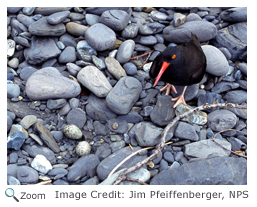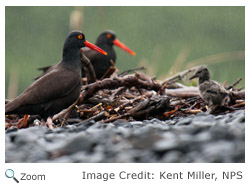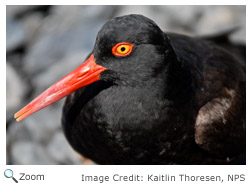Life Cycle
 The female black oyster catcher lays two to three eggs among pebbles in a shallow rocky depression or in a hollow on the beach above the high tide line. The nest is built by both the male and the female. They will create a scrape or depression in the ground and then pick up and toss shells and bits of rocks and pebbles into the depression with a backwards or sideways flip of their heads. They use the same nest year-after-year. Both the male and the female take turns incubating the eggs.
The female black oyster catcher lays two to three eggs among pebbles in a shallow rocky depression or in a hollow on the beach above the high tide line. The nest is built by both the male and the female. They will create a scrape or depression in the ground and then pick up and toss shells and bits of rocks and pebbles into the depression with a backwards or sideways flip of their heads. They use the same nest year-after-year. Both the male and the female take turns incubating the eggs.
 The eggs incubate for 24-29 days and the chicks fledge in about 35 days. The chicks remain close to the nest at first. One of the parents will stay with them while the other parent forages for food to bring back to the nest. Eventually, the chicks will go with their parents to feeding areas. The chicks fledge at about five weeks and will forage on their own, but they will still occasionally be fed by their parents. The female has one brood a year.
The eggs incubate for 24-29 days and the chicks fledge in about 35 days. The chicks remain close to the nest at first. One of the parents will stay with them while the other parent forages for food to bring back to the nest. Eventually, the chicks will go with their parents to feeding areas. The chicks fledge at about five weeks and will forage on their own, but they will still occasionally be fed by their parents. The female has one brood a year.
Behavior
 Black oystercatchers are non-migratory. They may move a little in the spring and fall, but they usually remain close to their nesting area.
Black oystercatchers are non-migratory. They may move a little in the spring and fall, but they usually remain close to their nesting area.